Evaluating COVID-19's Impact on Trade, Purchasing, and Inflation
VerifiedAdded on 2023/06/13
|11
|3833
|375
Essay
AI Summary
This essay provides a comprehensive analysis of the macroeconomic impacts of the COVID-19 pandemic, focusing on its effects on local and international trade, consumer purchasing behavior, and inflation. It highlights the significant decline in global trade due to the pandemic, the shift in consumer priorities towards essential goods, and the resulting changes in shopping patterns. The essay also explores the impact of COVID-19 on inflation, noting the rise in consumer prices and the challenges faced by businesses and economies worldwide. Furthermore, it touches upon the moderating role of vaccination on the economy. The document concludes with recommendations based on the analysis. Desklib offers a platform to explore similar assignments and past papers for students.
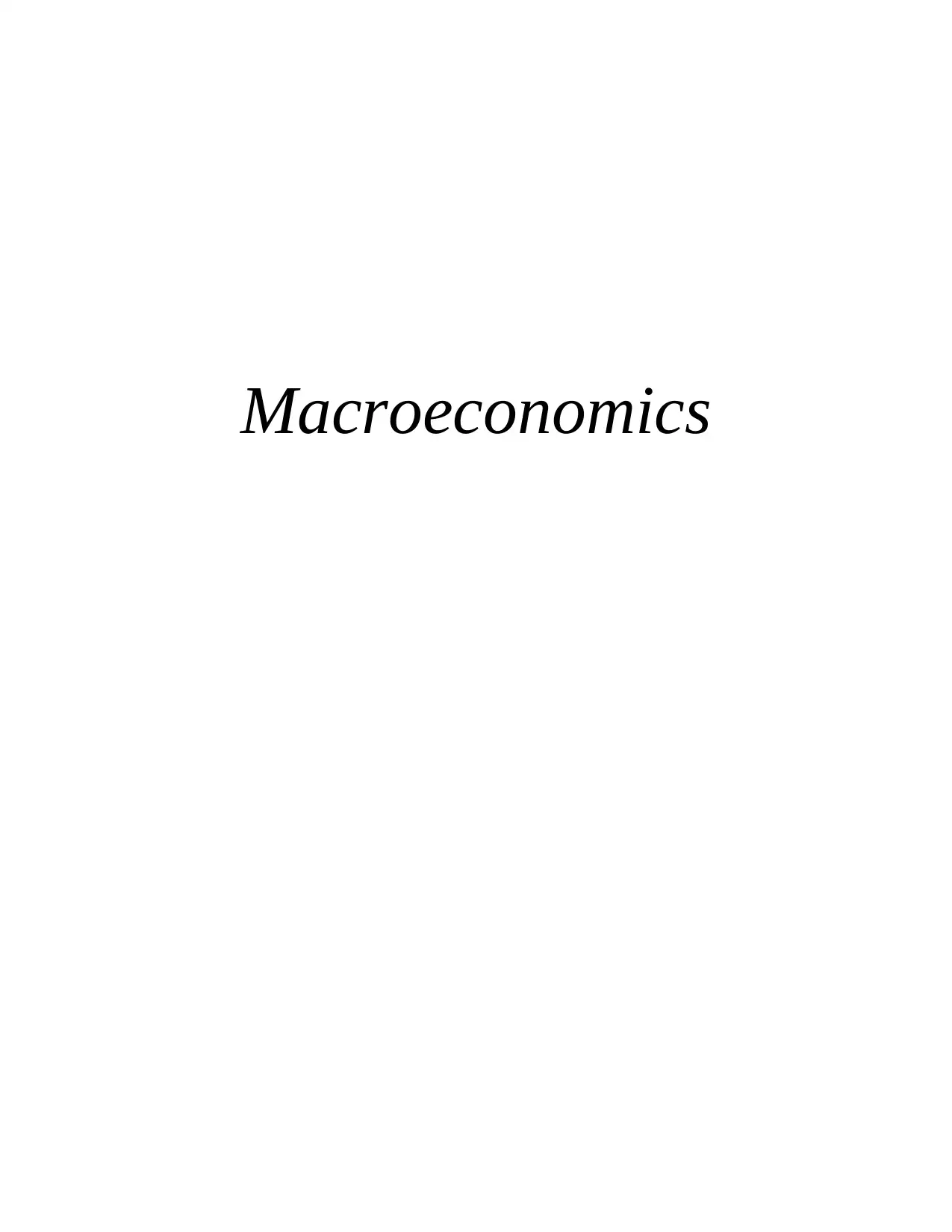
Macroeconomics
Paraphrase This Document
Need a fresh take? Get an instant paraphrase of this document with our AI Paraphraser
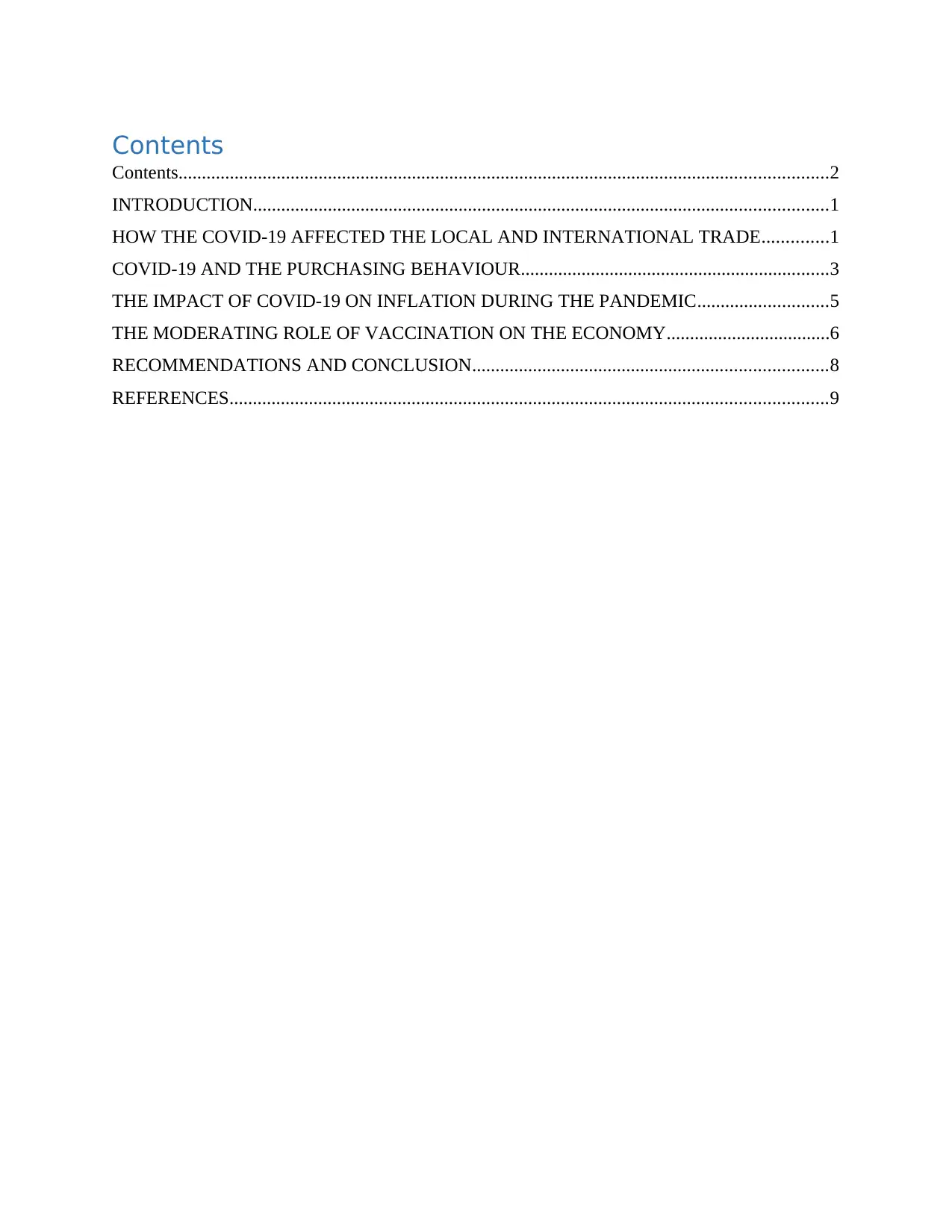
Contents
Contents...........................................................................................................................................2
INTRODUCTION...........................................................................................................................1
HOW THE COVID-19 AFFECTED THE LOCAL AND INTERNATIONAL TRADE..............1
COVID-19 AND THE PURCHASING BEHAVIOUR..................................................................3
THE IMPACT OF COVID-19 ON INFLATION DURING THE PANDEMIC............................5
THE MODERATING ROLE OF VACCINATION ON THE ECONOMY...................................6
RECOMMENDATIONS AND CONCLUSION............................................................................8
REFERENCES................................................................................................................................9
Contents...........................................................................................................................................2
INTRODUCTION...........................................................................................................................1
HOW THE COVID-19 AFFECTED THE LOCAL AND INTERNATIONAL TRADE..............1
COVID-19 AND THE PURCHASING BEHAVIOUR..................................................................3
THE IMPACT OF COVID-19 ON INFLATION DURING THE PANDEMIC............................5
THE MODERATING ROLE OF VACCINATION ON THE ECONOMY...................................6
RECOMMENDATIONS AND CONCLUSION............................................................................8
REFERENCES................................................................................................................................9
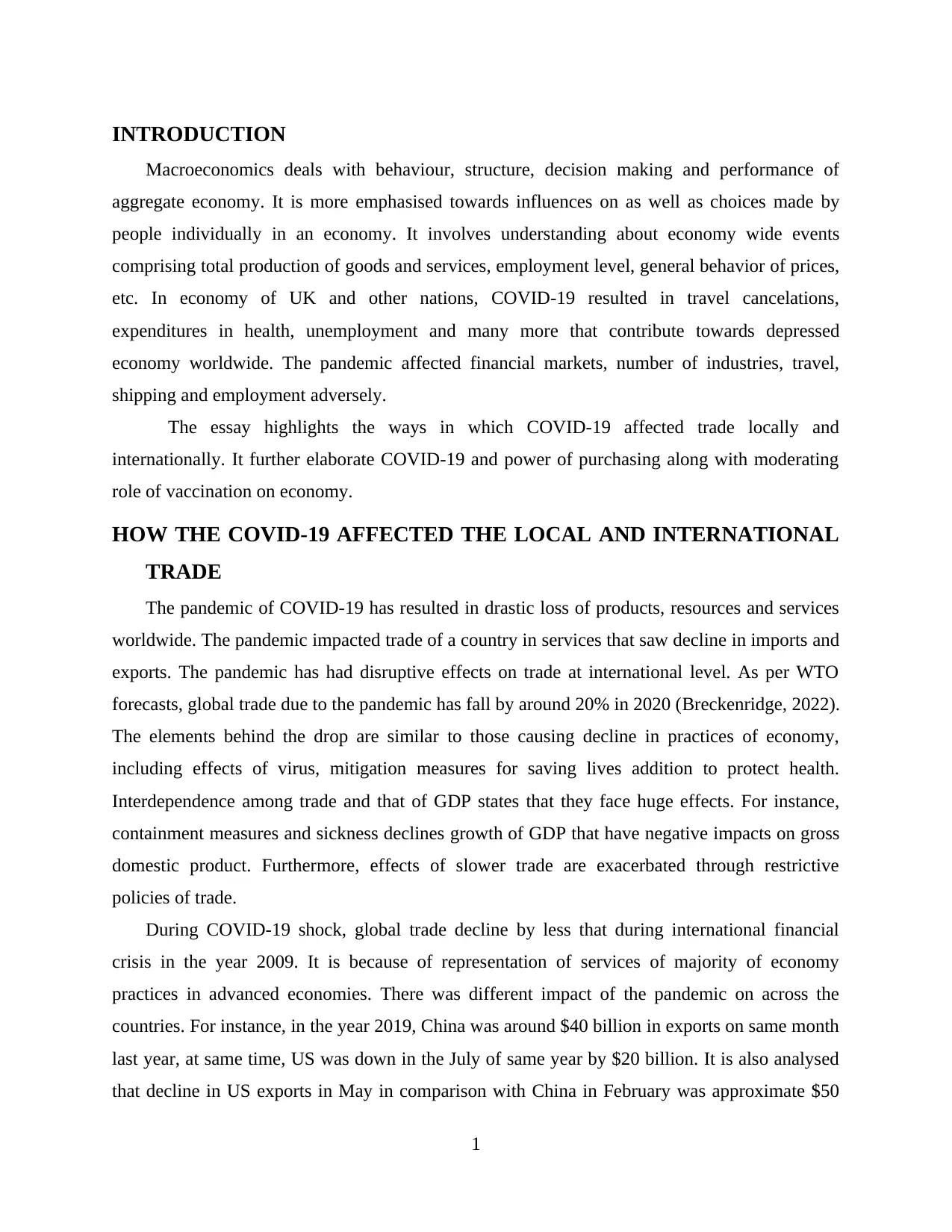
INTRODUCTION
Macroeconomics deals with behaviour, structure, decision making and performance of
aggregate economy. It is more emphasised towards influences on as well as choices made by
people individually in an economy. It involves understanding about economy wide events
comprising total production of goods and services, employment level, general behavior of prices,
etc. In economy of UK and other nations, COVID-19 resulted in travel cancelations,
expenditures in health, unemployment and many more that contribute towards depressed
economy worldwide. The pandemic affected financial markets, number of industries, travel,
shipping and employment adversely.
The essay highlights the ways in which COVID-19 affected trade locally and
internationally. It further elaborate COVID-19 and power of purchasing along with moderating
role of vaccination on economy.
HOW THE COVID-19 AFFECTED THE LOCAL AND INTERNATIONAL
TRADE
The pandemic of COVID-19 has resulted in drastic loss of products, resources and services
worldwide. The pandemic impacted trade of a country in services that saw decline in imports and
exports. The pandemic has had disruptive effects on trade at international level. As per WTO
forecasts, global trade due to the pandemic has fall by around 20% in 2020 (Breckenridge, 2022).
The elements behind the drop are similar to those causing decline in practices of economy,
including effects of virus, mitigation measures for saving lives addition to protect health.
Interdependence among trade and that of GDP states that they face huge effects. For instance,
containment measures and sickness declines growth of GDP that have negative impacts on gross
domestic product. Furthermore, effects of slower trade are exacerbated through restrictive
policies of trade.
During COVID-19 shock, global trade decline by less that during international financial
crisis in the year 2009. It is because of representation of services of majority of economy
practices in advanced economies. There was different impact of the pandemic on across the
countries. For instance, in the year 2019, China was around $40 billion in exports on same month
last year, at same time, US was down in the July of same year by $20 billion. It is also analysed
that decline in US exports in May in comparison with China in February was approximate $50
1
Macroeconomics deals with behaviour, structure, decision making and performance of
aggregate economy. It is more emphasised towards influences on as well as choices made by
people individually in an economy. It involves understanding about economy wide events
comprising total production of goods and services, employment level, general behavior of prices,
etc. In economy of UK and other nations, COVID-19 resulted in travel cancelations,
expenditures in health, unemployment and many more that contribute towards depressed
economy worldwide. The pandemic affected financial markets, number of industries, travel,
shipping and employment adversely.
The essay highlights the ways in which COVID-19 affected trade locally and
internationally. It further elaborate COVID-19 and power of purchasing along with moderating
role of vaccination on economy.
HOW THE COVID-19 AFFECTED THE LOCAL AND INTERNATIONAL
TRADE
The pandemic of COVID-19 has resulted in drastic loss of products, resources and services
worldwide. The pandemic impacted trade of a country in services that saw decline in imports and
exports. The pandemic has had disruptive effects on trade at international level. As per WTO
forecasts, global trade due to the pandemic has fall by around 20% in 2020 (Breckenridge, 2022).
The elements behind the drop are similar to those causing decline in practices of economy,
including effects of virus, mitigation measures for saving lives addition to protect health.
Interdependence among trade and that of GDP states that they face huge effects. For instance,
containment measures and sickness declines growth of GDP that have negative impacts on gross
domestic product. Furthermore, effects of slower trade are exacerbated through restrictive
policies of trade.
During COVID-19 shock, global trade decline by less that during international financial
crisis in the year 2009. It is because of representation of services of majority of economy
practices in advanced economies. There was different impact of the pandemic on across the
countries. For instance, in the year 2019, China was around $40 billion in exports on same month
last year, at same time, US was down in the July of same year by $20 billion. It is also analysed
that decline in US exports in May in comparison with China in February was approximate $50
1
⊘ This is a preview!⊘
Do you want full access?
Subscribe today to unlock all pages.

Trusted by 1+ million students worldwide
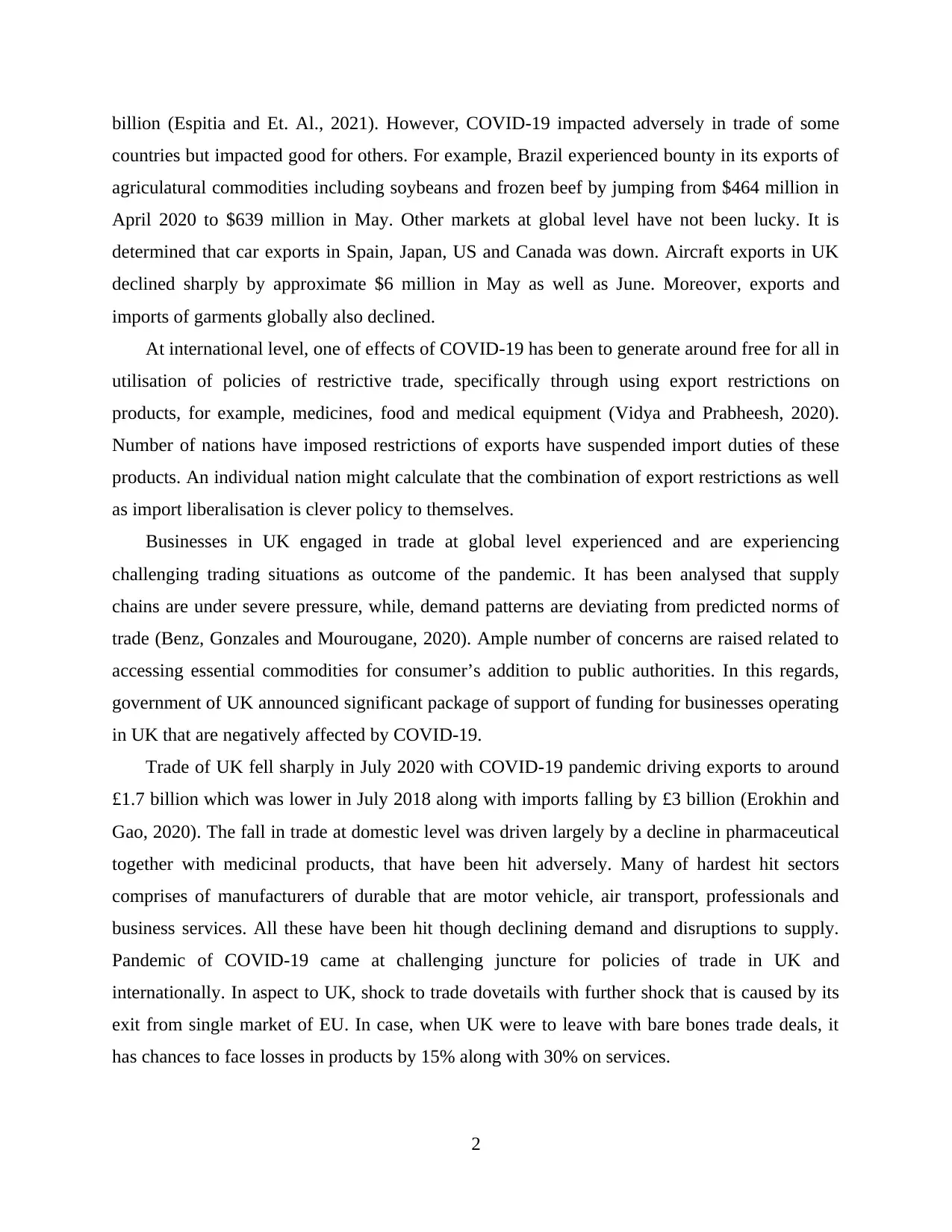
billion (Espitia and Et. Al., 2021). However, COVID-19 impacted adversely in trade of some
countries but impacted good for others. For example, Brazil experienced bounty in its exports of
agriculatural commodities including soybeans and frozen beef by jumping from $464 million in
April 2020 to $639 million in May. Other markets at global level have not been lucky. It is
determined that car exports in Spain, Japan, US and Canada was down. Aircraft exports in UK
declined sharply by approximate $6 million in May as well as June. Moreover, exports and
imports of garments globally also declined.
At international level, one of effects of COVID-19 has been to generate around free for all in
utilisation of policies of restrictive trade, specifically through using export restrictions on
products, for example, medicines, food and medical equipment (Vidya and Prabheesh, 2020).
Number of nations have imposed restrictions of exports have suspended import duties of these
products. An individual nation might calculate that the combination of export restrictions as well
as import liberalisation is clever policy to themselves.
Businesses in UK engaged in trade at global level experienced and are experiencing
challenging trading situations as outcome of the pandemic. It has been analysed that supply
chains are under severe pressure, while, demand patterns are deviating from predicted norms of
trade (Benz, Gonzales and Mourougane, 2020). Ample number of concerns are raised related to
accessing essential commodities for consumer’s addition to public authorities. In this regards,
government of UK announced significant package of support of funding for businesses operating
in UK that are negatively affected by COVID-19.
Trade of UK fell sharply in July 2020 with COVID-19 pandemic driving exports to around
£1.7 billion which was lower in July 2018 along with imports falling by £3 billion (Erokhin and
Gao, 2020). The fall in trade at domestic level was driven largely by a decline in pharmaceutical
together with medicinal products, that have been hit adversely. Many of hardest hit sectors
comprises of manufacturers of durable that are motor vehicle, air transport, professionals and
business services. All these have been hit though declining demand and disruptions to supply.
Pandemic of COVID-19 came at challenging juncture for policies of trade in UK and
internationally. In aspect to UK, shock to trade dovetails with further shock that is caused by its
exit from single market of EU. In case, when UK were to leave with bare bones trade deals, it
has chances to face losses in products by 15% along with 30% on services.
2
countries but impacted good for others. For example, Brazil experienced bounty in its exports of
agriculatural commodities including soybeans and frozen beef by jumping from $464 million in
April 2020 to $639 million in May. Other markets at global level have not been lucky. It is
determined that car exports in Spain, Japan, US and Canada was down. Aircraft exports in UK
declined sharply by approximate $6 million in May as well as June. Moreover, exports and
imports of garments globally also declined.
At international level, one of effects of COVID-19 has been to generate around free for all in
utilisation of policies of restrictive trade, specifically through using export restrictions on
products, for example, medicines, food and medical equipment (Vidya and Prabheesh, 2020).
Number of nations have imposed restrictions of exports have suspended import duties of these
products. An individual nation might calculate that the combination of export restrictions as well
as import liberalisation is clever policy to themselves.
Businesses in UK engaged in trade at global level experienced and are experiencing
challenging trading situations as outcome of the pandemic. It has been analysed that supply
chains are under severe pressure, while, demand patterns are deviating from predicted norms of
trade (Benz, Gonzales and Mourougane, 2020). Ample number of concerns are raised related to
accessing essential commodities for consumer’s addition to public authorities. In this regards,
government of UK announced significant package of support of funding for businesses operating
in UK that are negatively affected by COVID-19.
Trade of UK fell sharply in July 2020 with COVID-19 pandemic driving exports to around
£1.7 billion which was lower in July 2018 along with imports falling by £3 billion (Erokhin and
Gao, 2020). The fall in trade at domestic level was driven largely by a decline in pharmaceutical
together with medicinal products, that have been hit adversely. Many of hardest hit sectors
comprises of manufacturers of durable that are motor vehicle, air transport, professionals and
business services. All these have been hit though declining demand and disruptions to supply.
Pandemic of COVID-19 came at challenging juncture for policies of trade in UK and
internationally. In aspect to UK, shock to trade dovetails with further shock that is caused by its
exit from single market of EU. In case, when UK were to leave with bare bones trade deals, it
has chances to face losses in products by 15% along with 30% on services.
2
Paraphrase This Document
Need a fresh take? Get an instant paraphrase of this document with our AI Paraphraser
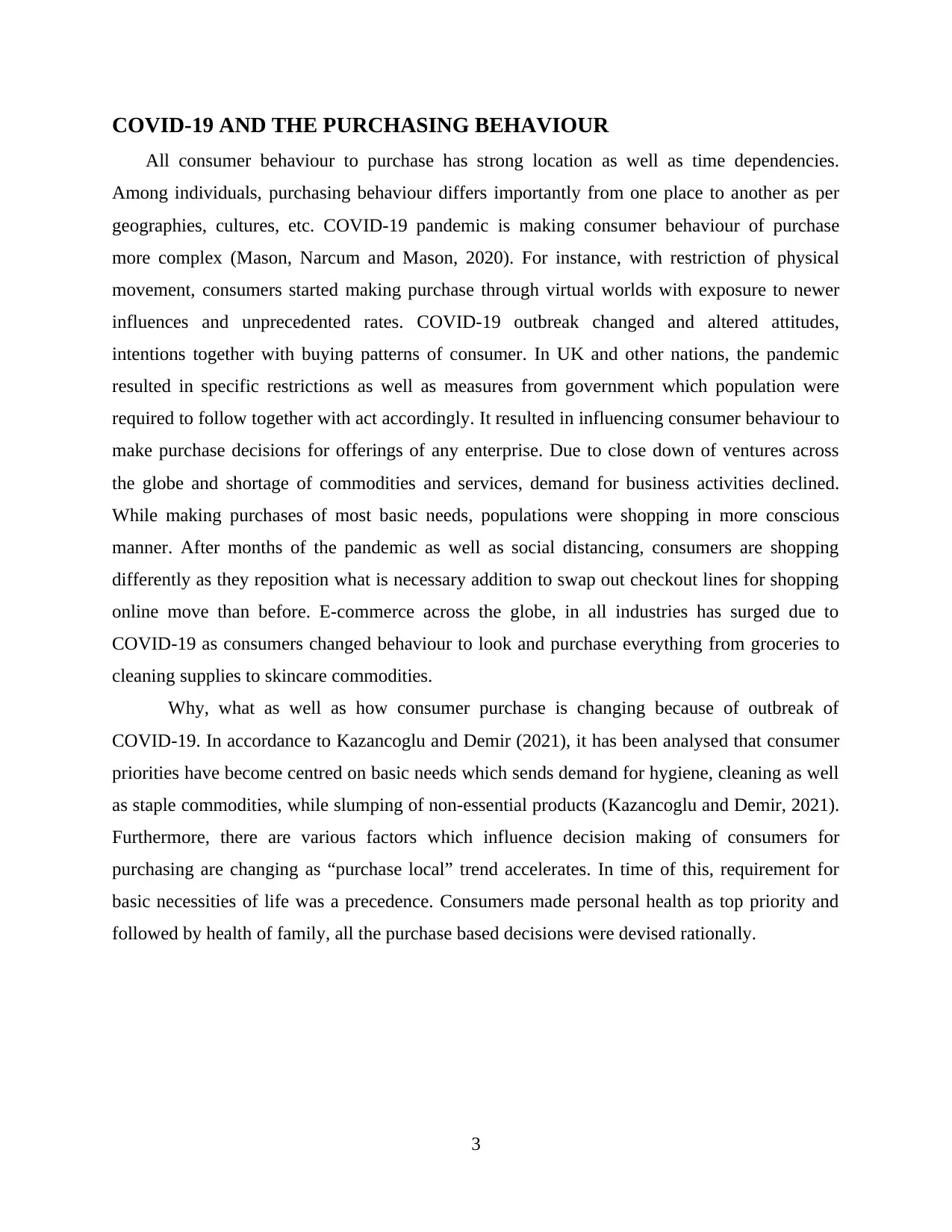
COVID-19 AND THE PURCHASING BEHAVIOUR
All consumer behaviour to purchase has strong location as well as time dependencies.
Among individuals, purchasing behaviour differs importantly from one place to another as per
geographies, cultures, etc. COVID-19 pandemic is making consumer behaviour of purchase
more complex (Mason, Narcum and Mason, 2020). For instance, with restriction of physical
movement, consumers started making purchase through virtual worlds with exposure to newer
influences and unprecedented rates. COVID-19 outbreak changed and altered attitudes,
intentions together with buying patterns of consumer. In UK and other nations, the pandemic
resulted in specific restrictions as well as measures from government which population were
required to follow together with act accordingly. It resulted in influencing consumer behaviour to
make purchase decisions for offerings of any enterprise. Due to close down of ventures across
the globe and shortage of commodities and services, demand for business activities declined.
While making purchases of most basic needs, populations were shopping in more conscious
manner. After months of the pandemic as well as social distancing, consumers are shopping
differently as they reposition what is necessary addition to swap out checkout lines for shopping
online move than before. E-commerce across the globe, in all industries has surged due to
COVID-19 as consumers changed behaviour to look and purchase everything from groceries to
cleaning supplies to skincare commodities.
Why, what as well as how consumer purchase is changing because of outbreak of
COVID-19. In accordance to Kazancoglu and Demir (2021), it has been analysed that consumer
priorities have become centred on basic needs which sends demand for hygiene, cleaning as well
as staple commodities, while slumping of non-essential products (Kazancoglu and Demir, 2021).
Furthermore, there are various factors which influence decision making of consumers for
purchasing are changing as “purchase local” trend accelerates. In time of this, requirement for
basic necessities of life was a precedence. Consumers made personal health as top priority and
followed by health of family, all the purchase based decisions were devised rationally.
3
All consumer behaviour to purchase has strong location as well as time dependencies.
Among individuals, purchasing behaviour differs importantly from one place to another as per
geographies, cultures, etc. COVID-19 pandemic is making consumer behaviour of purchase
more complex (Mason, Narcum and Mason, 2020). For instance, with restriction of physical
movement, consumers started making purchase through virtual worlds with exposure to newer
influences and unprecedented rates. COVID-19 outbreak changed and altered attitudes,
intentions together with buying patterns of consumer. In UK and other nations, the pandemic
resulted in specific restrictions as well as measures from government which population were
required to follow together with act accordingly. It resulted in influencing consumer behaviour to
make purchase decisions for offerings of any enterprise. Due to close down of ventures across
the globe and shortage of commodities and services, demand for business activities declined.
While making purchases of most basic needs, populations were shopping in more conscious
manner. After months of the pandemic as well as social distancing, consumers are shopping
differently as they reposition what is necessary addition to swap out checkout lines for shopping
online move than before. E-commerce across the globe, in all industries has surged due to
COVID-19 as consumers changed behaviour to look and purchase everything from groceries to
cleaning supplies to skincare commodities.
Why, what as well as how consumer purchase is changing because of outbreak of
COVID-19. In accordance to Kazancoglu and Demir (2021), it has been analysed that consumer
priorities have become centred on basic needs which sends demand for hygiene, cleaning as well
as staple commodities, while slumping of non-essential products (Kazancoglu and Demir, 2021).
Furthermore, there are various factors which influence decision making of consumers for
purchasing are changing as “purchase local” trend accelerates. In time of this, requirement for
basic necessities of life was a precedence. Consumers made personal health as top priority and
followed by health of family, all the purchase based decisions were devised rationally.
3
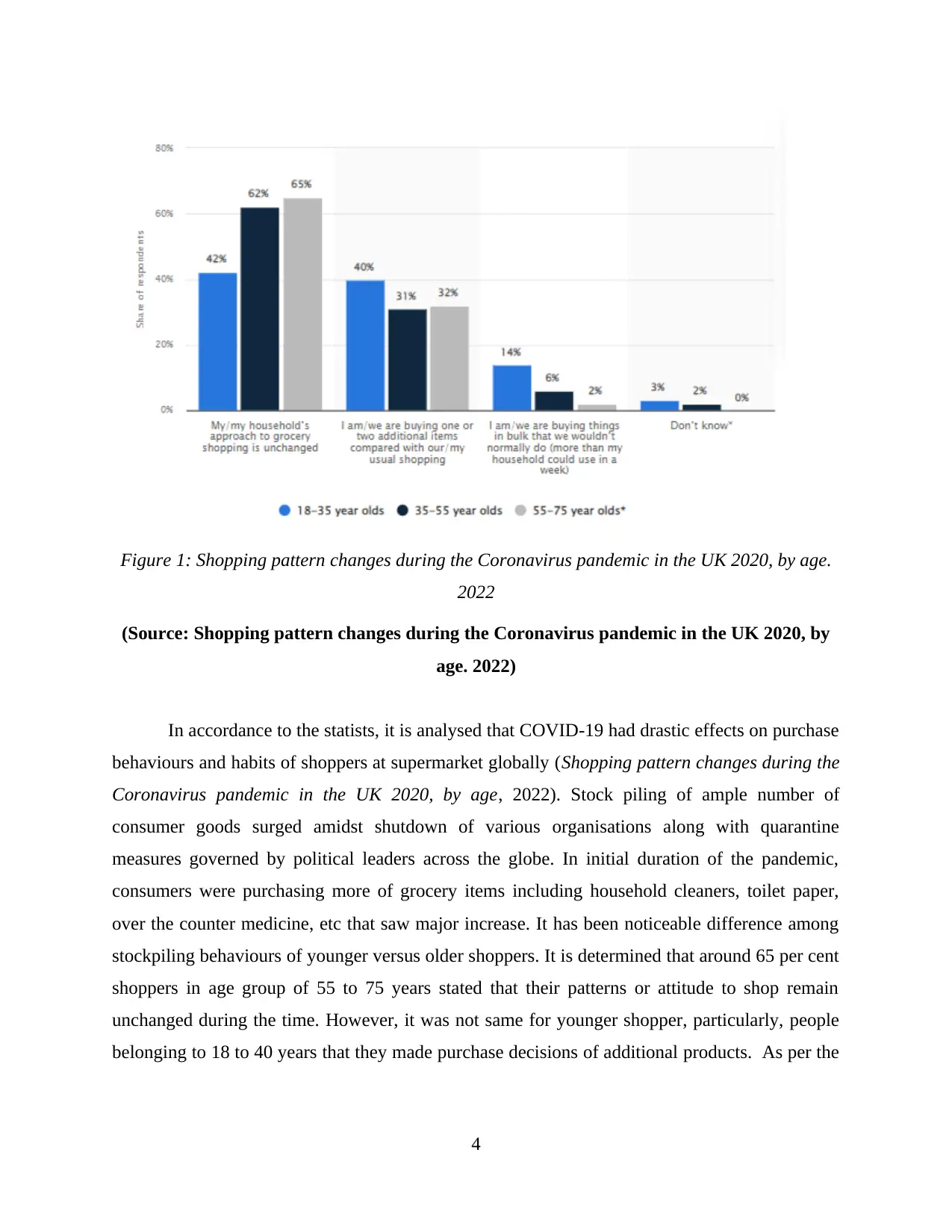
Figure 1: Shopping pattern changes during the Coronavirus pandemic in the UK 2020, by age.
2022
(Source: Shopping pattern changes during the Coronavirus pandemic in the UK 2020, by
age. 2022)
In accordance to the statists, it is analysed that COVID-19 had drastic effects on purchase
behaviours and habits of shoppers at supermarket globally (Shopping pattern changes during the
Coronavirus pandemic in the UK 2020, by age, 2022). Stock piling of ample number of
consumer goods surged amidst shutdown of various organisations along with quarantine
measures governed by political leaders across the globe. In initial duration of the pandemic,
consumers were purchasing more of grocery items including household cleaners, toilet paper,
over the counter medicine, etc that saw major increase. It has been noticeable difference among
stockpiling behaviours of younger versus older shoppers. It is determined that around 65 per cent
shoppers in age group of 55 to 75 years stated that their patterns or attitude to shop remain
unchanged during the time. However, it was not same for younger shopper, particularly, people
belonging to 18 to 40 years that they made purchase decisions of additional products. As per the
4
2022
(Source: Shopping pattern changes during the Coronavirus pandemic in the UK 2020, by
age. 2022)
In accordance to the statists, it is analysed that COVID-19 had drastic effects on purchase
behaviours and habits of shoppers at supermarket globally (Shopping pattern changes during the
Coronavirus pandemic in the UK 2020, by age, 2022). Stock piling of ample number of
consumer goods surged amidst shutdown of various organisations along with quarantine
measures governed by political leaders across the globe. In initial duration of the pandemic,
consumers were purchasing more of grocery items including household cleaners, toilet paper,
over the counter medicine, etc that saw major increase. It has been noticeable difference among
stockpiling behaviours of younger versus older shoppers. It is determined that around 65 per cent
shoppers in age group of 55 to 75 years stated that their patterns or attitude to shop remain
unchanged during the time. However, it was not same for younger shopper, particularly, people
belonging to 18 to 40 years that they made purchase decisions of additional products. As per the
4
⊘ This is a preview!⊘
Do you want full access?
Subscribe today to unlock all pages.

Trusted by 1+ million students worldwide
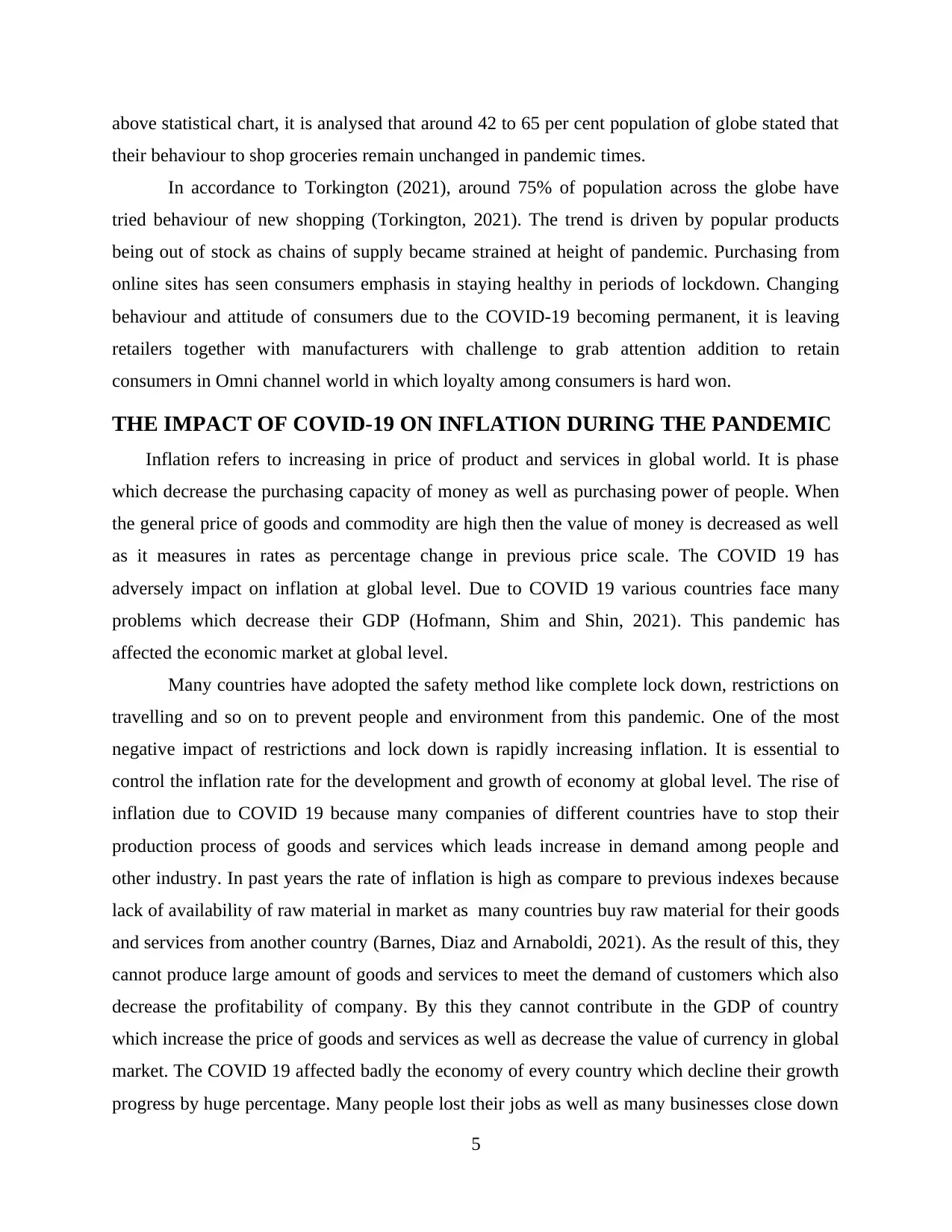
above statistical chart, it is analysed that around 42 to 65 per cent population of globe stated that
their behaviour to shop groceries remain unchanged in pandemic times.
In accordance to Torkington (2021), around 75% of population across the globe have
tried behaviour of new shopping (Torkington, 2021). The trend is driven by popular products
being out of stock as chains of supply became strained at height of pandemic. Purchasing from
online sites has seen consumers emphasis in staying healthy in periods of lockdown. Changing
behaviour and attitude of consumers due to the COVID-19 becoming permanent, it is leaving
retailers together with manufacturers with challenge to grab attention addition to retain
consumers in Omni channel world in which loyalty among consumers is hard won.
THE IMPACT OF COVID-19 ON INFLATION DURING THE PANDEMIC
Inflation refers to increasing in price of product and services in global world. It is phase
which decrease the purchasing capacity of money as well as purchasing power of people. When
the general price of goods and commodity are high then the value of money is decreased as well
as it measures in rates as percentage change in previous price scale. The COVID 19 has
adversely impact on inflation at global level. Due to COVID 19 various countries face many
problems which decrease their GDP (Hofmann, Shim and Shin, 2021). This pandemic has
affected the economic market at global level.
Many countries have adopted the safety method like complete lock down, restrictions on
travelling and so on to prevent people and environment from this pandemic. One of the most
negative impact of restrictions and lock down is rapidly increasing inflation. It is essential to
control the inflation rate for the development and growth of economy at global level. The rise of
inflation due to COVID 19 because many companies of different countries have to stop their
production process of goods and services which leads increase in demand among people and
other industry. In past years the rate of inflation is high as compare to previous indexes because
lack of availability of raw material in market as many countries buy raw material for their goods
and services from another country (Barnes, Diaz and Arnaboldi, 2021). As the result of this, they
cannot produce large amount of goods and services to meet the demand of customers which also
decrease the profitability of company. By this they cannot contribute in the GDP of country
which increase the price of goods and services as well as decrease the value of currency in global
market. The COVID 19 affected badly the economy of every country which decline their growth
progress by huge percentage. Many people lost their jobs as well as many businesses close down
5
their behaviour to shop groceries remain unchanged in pandemic times.
In accordance to Torkington (2021), around 75% of population across the globe have
tried behaviour of new shopping (Torkington, 2021). The trend is driven by popular products
being out of stock as chains of supply became strained at height of pandemic. Purchasing from
online sites has seen consumers emphasis in staying healthy in periods of lockdown. Changing
behaviour and attitude of consumers due to the COVID-19 becoming permanent, it is leaving
retailers together with manufacturers with challenge to grab attention addition to retain
consumers in Omni channel world in which loyalty among consumers is hard won.
THE IMPACT OF COVID-19 ON INFLATION DURING THE PANDEMIC
Inflation refers to increasing in price of product and services in global world. It is phase
which decrease the purchasing capacity of money as well as purchasing power of people. When
the general price of goods and commodity are high then the value of money is decreased as well
as it measures in rates as percentage change in previous price scale. The COVID 19 has
adversely impact on inflation at global level. Due to COVID 19 various countries face many
problems which decrease their GDP (Hofmann, Shim and Shin, 2021). This pandemic has
affected the economic market at global level.
Many countries have adopted the safety method like complete lock down, restrictions on
travelling and so on to prevent people and environment from this pandemic. One of the most
negative impact of restrictions and lock down is rapidly increasing inflation. It is essential to
control the inflation rate for the development and growth of economy at global level. The rise of
inflation due to COVID 19 because many companies of different countries have to stop their
production process of goods and services which leads increase in demand among people and
other industry. In past years the rate of inflation is high as compare to previous indexes because
lack of availability of raw material in market as many countries buy raw material for their goods
and services from another country (Barnes, Diaz and Arnaboldi, 2021). As the result of this, they
cannot produce large amount of goods and services to meet the demand of customers which also
decrease the profitability of company. By this they cannot contribute in the GDP of country
which increase the price of goods and services as well as decrease the value of currency in global
market. The COVID 19 affected badly the economy of every country which decline their growth
progress by huge percentage. Many people lost their jobs as well as many businesses close down
5
Paraphrase This Document
Need a fresh take? Get an instant paraphrase of this document with our AI Paraphraser
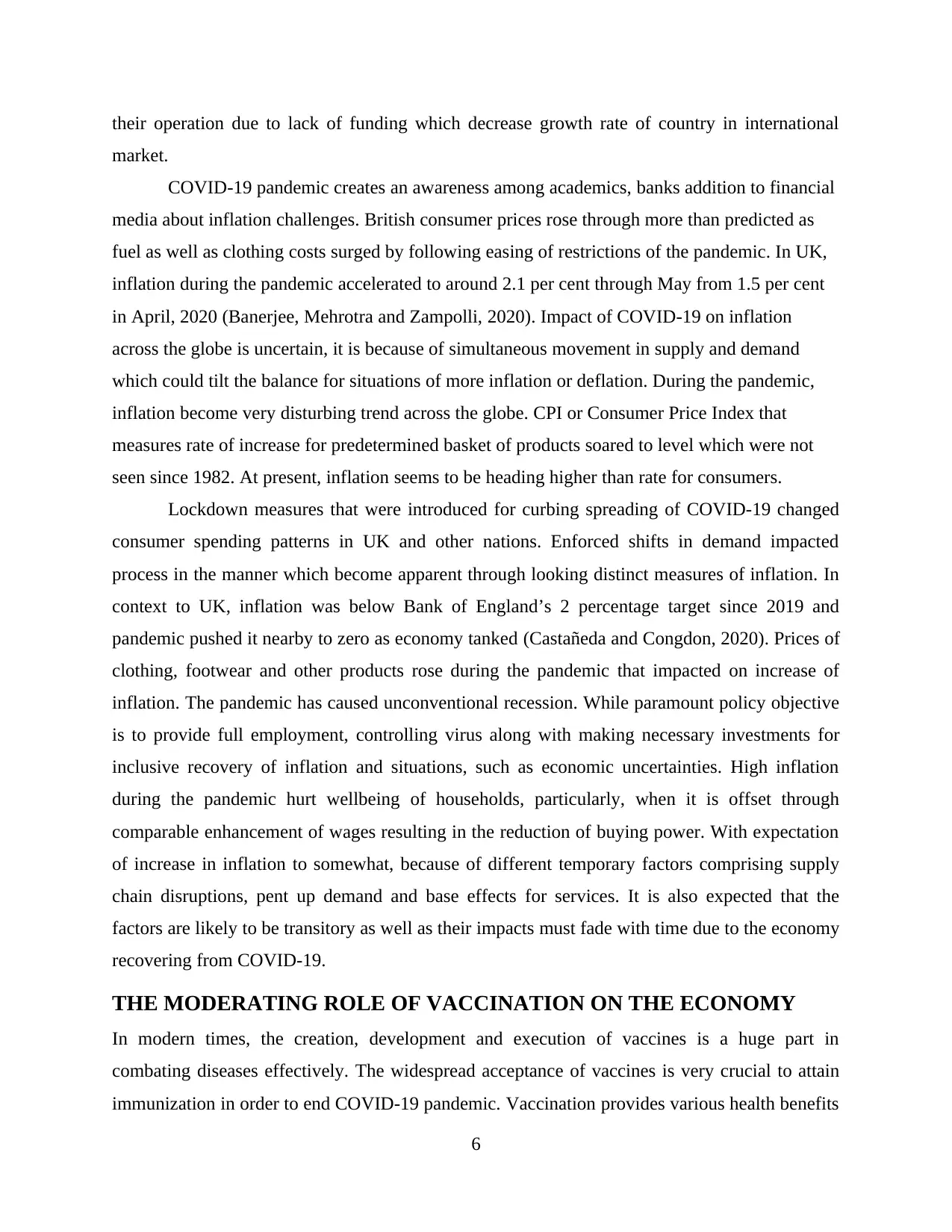
their operation due to lack of funding which decrease growth rate of country in international
market.
COVID-19 pandemic creates an awareness among academics, banks addition to financial
media about inflation challenges. British consumer prices rose through more than predicted as
fuel as well as clothing costs surged by following easing of restrictions of the pandemic. In UK,
inflation during the pandemic accelerated to around 2.1 per cent through May from 1.5 per cent
in April, 2020 (Banerjee, Mehrotra and Zampolli, 2020). Impact of COVID-19 on inflation
across the globe is uncertain, it is because of simultaneous movement in supply and demand
which could tilt the balance for situations of more inflation or deflation. During the pandemic,
inflation become very disturbing trend across the globe. CPI or Consumer Price Index that
measures rate of increase for predetermined basket of products soared to level which were not
seen since 1982. At present, inflation seems to be heading higher than rate for consumers.
Lockdown measures that were introduced for curbing spreading of COVID-19 changed
consumer spending patterns in UK and other nations. Enforced shifts in demand impacted
process in the manner which become apparent through looking distinct measures of inflation. In
context to UK, inflation was below Bank of England’s 2 percentage target since 2019 and
pandemic pushed it nearby to zero as economy tanked (Castañeda and Congdon, 2020). Prices of
clothing, footwear and other products rose during the pandemic that impacted on increase of
inflation. The pandemic has caused unconventional recession. While paramount policy objective
is to provide full employment, controlling virus along with making necessary investments for
inclusive recovery of inflation and situations, such as economic uncertainties. High inflation
during the pandemic hurt wellbeing of households, particularly, when it is offset through
comparable enhancement of wages resulting in the reduction of buying power. With expectation
of increase in inflation to somewhat, because of different temporary factors comprising supply
chain disruptions, pent up demand and base effects for services. It is also expected that the
factors are likely to be transitory as well as their impacts must fade with time due to the economy
recovering from COVID-19.
THE MODERATING ROLE OF VACCINATION ON THE ECONOMY
In modern times, the creation, development and execution of vaccines is a huge part in
combating diseases effectively. The widespread acceptance of vaccines is very crucial to attain
immunization in order to end COVID-19 pandemic. Vaccination provides various health benefits
6
market.
COVID-19 pandemic creates an awareness among academics, banks addition to financial
media about inflation challenges. British consumer prices rose through more than predicted as
fuel as well as clothing costs surged by following easing of restrictions of the pandemic. In UK,
inflation during the pandemic accelerated to around 2.1 per cent through May from 1.5 per cent
in April, 2020 (Banerjee, Mehrotra and Zampolli, 2020). Impact of COVID-19 on inflation
across the globe is uncertain, it is because of simultaneous movement in supply and demand
which could tilt the balance for situations of more inflation or deflation. During the pandemic,
inflation become very disturbing trend across the globe. CPI or Consumer Price Index that
measures rate of increase for predetermined basket of products soared to level which were not
seen since 1982. At present, inflation seems to be heading higher than rate for consumers.
Lockdown measures that were introduced for curbing spreading of COVID-19 changed
consumer spending patterns in UK and other nations. Enforced shifts in demand impacted
process in the manner which become apparent through looking distinct measures of inflation. In
context to UK, inflation was below Bank of England’s 2 percentage target since 2019 and
pandemic pushed it nearby to zero as economy tanked (Castañeda and Congdon, 2020). Prices of
clothing, footwear and other products rose during the pandemic that impacted on increase of
inflation. The pandemic has caused unconventional recession. While paramount policy objective
is to provide full employment, controlling virus along with making necessary investments for
inclusive recovery of inflation and situations, such as economic uncertainties. High inflation
during the pandemic hurt wellbeing of households, particularly, when it is offset through
comparable enhancement of wages resulting in the reduction of buying power. With expectation
of increase in inflation to somewhat, because of different temporary factors comprising supply
chain disruptions, pent up demand and base effects for services. It is also expected that the
factors are likely to be transitory as well as their impacts must fade with time due to the economy
recovering from COVID-19.
THE MODERATING ROLE OF VACCINATION ON THE ECONOMY
In modern times, the creation, development and execution of vaccines is a huge part in
combating diseases effectively. The widespread acceptance of vaccines is very crucial to attain
immunization in order to end COVID-19 pandemic. Vaccination provides various health benefits
6
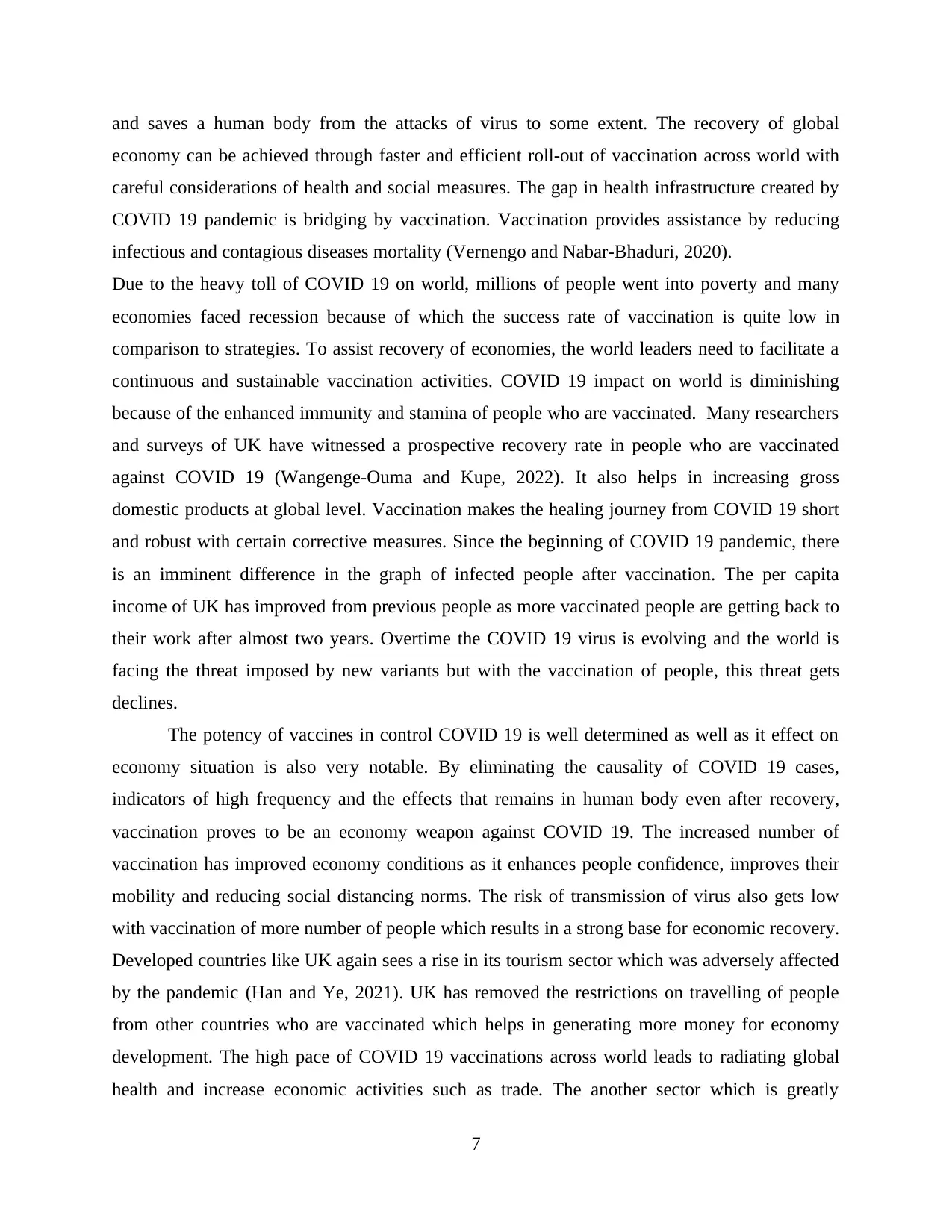
and saves a human body from the attacks of virus to some extent. The recovery of global
economy can be achieved through faster and efficient roll-out of vaccination across world with
careful considerations of health and social measures. The gap in health infrastructure created by
COVID 19 pandemic is bridging by vaccination. Vaccination provides assistance by reducing
infectious and contagious diseases mortality (Vernengo and Nabar-Bhaduri, 2020).
Due to the heavy toll of COVID 19 on world, millions of people went into poverty and many
economies faced recession because of which the success rate of vaccination is quite low in
comparison to strategies. To assist recovery of economies, the world leaders need to facilitate a
continuous and sustainable vaccination activities. COVID 19 impact on world is diminishing
because of the enhanced immunity and stamina of people who are vaccinated. Many researchers
and surveys of UK have witnessed a prospective recovery rate in people who are vaccinated
against COVID 19 (Wangenge-Ouma and Kupe, 2022). It also helps in increasing gross
domestic products at global level. Vaccination makes the healing journey from COVID 19 short
and robust with certain corrective measures. Since the beginning of COVID 19 pandemic, there
is an imminent difference in the graph of infected people after vaccination. The per capita
income of UK has improved from previous people as more vaccinated people are getting back to
their work after almost two years. Overtime the COVID 19 virus is evolving and the world is
facing the threat imposed by new variants but with the vaccination of people, this threat gets
declines.
The potency of vaccines in control COVID 19 is well determined as well as it effect on
economy situation is also very notable. By eliminating the causality of COVID 19 cases,
indicators of high frequency and the effects that remains in human body even after recovery,
vaccination proves to be an economy weapon against COVID 19. The increased number of
vaccination has improved economy conditions as it enhances people confidence, improves their
mobility and reducing social distancing norms. The risk of transmission of virus also gets low
with vaccination of more number of people which results in a strong base for economic recovery.
Developed countries like UK again sees a rise in its tourism sector which was adversely affected
by the pandemic (Han and Ye, 2021). UK has removed the restrictions on travelling of people
from other countries who are vaccinated which helps in generating more money for economy
development. The high pace of COVID 19 vaccinations across world leads to radiating global
health and increase economic activities such as trade. The another sector which is greatly
7
economy can be achieved through faster and efficient roll-out of vaccination across world with
careful considerations of health and social measures. The gap in health infrastructure created by
COVID 19 pandemic is bridging by vaccination. Vaccination provides assistance by reducing
infectious and contagious diseases mortality (Vernengo and Nabar-Bhaduri, 2020).
Due to the heavy toll of COVID 19 on world, millions of people went into poverty and many
economies faced recession because of which the success rate of vaccination is quite low in
comparison to strategies. To assist recovery of economies, the world leaders need to facilitate a
continuous and sustainable vaccination activities. COVID 19 impact on world is diminishing
because of the enhanced immunity and stamina of people who are vaccinated. Many researchers
and surveys of UK have witnessed a prospective recovery rate in people who are vaccinated
against COVID 19 (Wangenge-Ouma and Kupe, 2022). It also helps in increasing gross
domestic products at global level. Vaccination makes the healing journey from COVID 19 short
and robust with certain corrective measures. Since the beginning of COVID 19 pandemic, there
is an imminent difference in the graph of infected people after vaccination. The per capita
income of UK has improved from previous people as more vaccinated people are getting back to
their work after almost two years. Overtime the COVID 19 virus is evolving and the world is
facing the threat imposed by new variants but with the vaccination of people, this threat gets
declines.
The potency of vaccines in control COVID 19 is well determined as well as it effect on
economy situation is also very notable. By eliminating the causality of COVID 19 cases,
indicators of high frequency and the effects that remains in human body even after recovery,
vaccination proves to be an economy weapon against COVID 19. The increased number of
vaccination has improved economy conditions as it enhances people confidence, improves their
mobility and reducing social distancing norms. The risk of transmission of virus also gets low
with vaccination of more number of people which results in a strong base for economic recovery.
Developed countries like UK again sees a rise in its tourism sector which was adversely affected
by the pandemic (Han and Ye, 2021). UK has removed the restrictions on travelling of people
from other countries who are vaccinated which helps in generating more money for economy
development. The high pace of COVID 19 vaccinations across world leads to radiating global
health and increase economic activities such as trade. The another sector which is greatly
7
⊘ This is a preview!⊘
Do you want full access?
Subscribe today to unlock all pages.

Trusted by 1+ million students worldwide
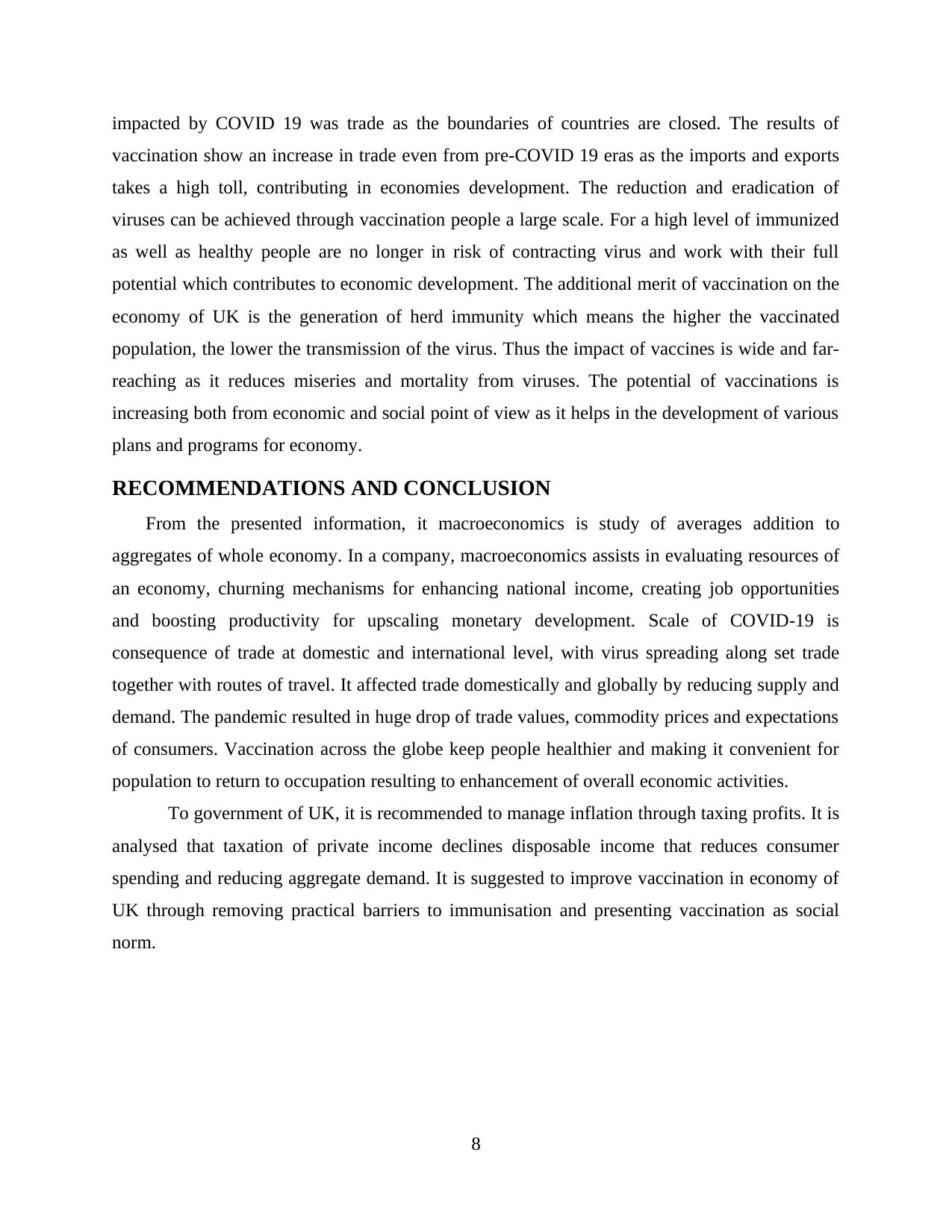
impacted by COVID 19 was trade as the boundaries of countries are closed. The results of
vaccination show an increase in trade even from pre-COVID 19 eras as the imports and exports
takes a high toll, contributing in economies development. The reduction and eradication of
viruses can be achieved through vaccination people a large scale. For a high level of immunized
as well as healthy people are no longer in risk of contracting virus and work with their full
potential which contributes to economic development. The additional merit of vaccination on the
economy of UK is the generation of herd immunity which means the higher the vaccinated
population, the lower the transmission of the virus. Thus the impact of vaccines is wide and far-
reaching as it reduces miseries and mortality from viruses. The potential of vaccinations is
increasing both from economic and social point of view as it helps in the development of various
plans and programs for economy.
RECOMMENDATIONS AND CONCLUSION
From the presented information, it macroeconomics is study of averages addition to
aggregates of whole economy. In a company, macroeconomics assists in evaluating resources of
an economy, churning mechanisms for enhancing national income, creating job opportunities
and boosting productivity for upscaling monetary development. Scale of COVID-19 is
consequence of trade at domestic and international level, with virus spreading along set trade
together with routes of travel. It affected trade domestically and globally by reducing supply and
demand. The pandemic resulted in huge drop of trade values, commodity prices and expectations
of consumers. Vaccination across the globe keep people healthier and making it convenient for
population to return to occupation resulting to enhancement of overall economic activities.
To government of UK, it is recommended to manage inflation through taxing profits. It is
analysed that taxation of private income declines disposable income that reduces consumer
spending and reducing aggregate demand. It is suggested to improve vaccination in economy of
UK through removing practical barriers to immunisation and presenting vaccination as social
norm.
8
vaccination show an increase in trade even from pre-COVID 19 eras as the imports and exports
takes a high toll, contributing in economies development. The reduction and eradication of
viruses can be achieved through vaccination people a large scale. For a high level of immunized
as well as healthy people are no longer in risk of contracting virus and work with their full
potential which contributes to economic development. The additional merit of vaccination on the
economy of UK is the generation of herd immunity which means the higher the vaccinated
population, the lower the transmission of the virus. Thus the impact of vaccines is wide and far-
reaching as it reduces miseries and mortality from viruses. The potential of vaccinations is
increasing both from economic and social point of view as it helps in the development of various
plans and programs for economy.
RECOMMENDATIONS AND CONCLUSION
From the presented information, it macroeconomics is study of averages addition to
aggregates of whole economy. In a company, macroeconomics assists in evaluating resources of
an economy, churning mechanisms for enhancing national income, creating job opportunities
and boosting productivity for upscaling monetary development. Scale of COVID-19 is
consequence of trade at domestic and international level, with virus spreading along set trade
together with routes of travel. It affected trade domestically and globally by reducing supply and
demand. The pandemic resulted in huge drop of trade values, commodity prices and expectations
of consumers. Vaccination across the globe keep people healthier and making it convenient for
population to return to occupation resulting to enhancement of overall economic activities.
To government of UK, it is recommended to manage inflation through taxing profits. It is
analysed that taxation of private income declines disposable income that reduces consumer
spending and reducing aggregate demand. It is suggested to improve vaccination in economy of
UK through removing practical barriers to immunisation and presenting vaccination as social
norm.
8
Paraphrase This Document
Need a fresh take? Get an instant paraphrase of this document with our AI Paraphraser
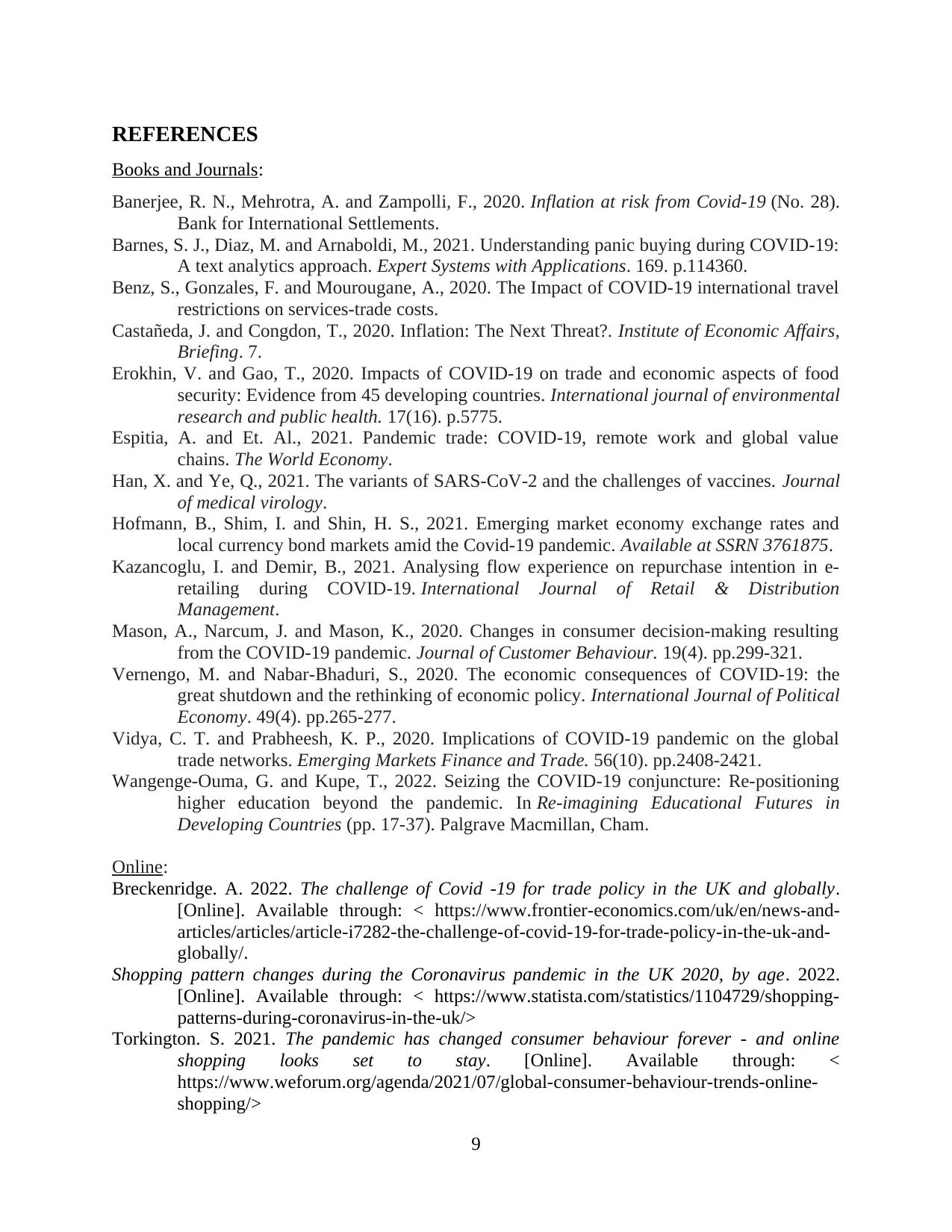
REFERENCES
Books and Journals:
Banerjee, R. N., Mehrotra, A. and Zampolli, F., 2020. Inflation at risk from Covid-19 (No. 28).
Bank for International Settlements.
Barnes, S. J., Diaz, M. and Arnaboldi, M., 2021. Understanding panic buying during COVID-19:
A text analytics approach. Expert Systems with Applications. 169. p.114360.
Benz, S., Gonzales, F. and Mourougane, A., 2020. The Impact of COVID-19 international travel
restrictions on services-trade costs.
Castañeda, J. and Congdon, T., 2020. Inflation: The Next Threat?. Institute of Economic Affairs,
Briefing. 7.
Erokhin, V. and Gao, T., 2020. Impacts of COVID-19 on trade and economic aspects of food
security: Evidence from 45 developing countries. International journal of environmental
research and public health. 17(16). p.5775.
Espitia, A. and Et. Al., 2021. Pandemic trade: COVID‐19, remote work and global value
chains. The World Economy.
Han, X. and Ye, Q., 2021. The variants of SARS‐CoV‐2 and the challenges of vaccines. Journal
of medical virology.
Hofmann, B., Shim, I. and Shin, H. S., 2021. Emerging market economy exchange rates and
local currency bond markets amid the Covid-19 pandemic. Available at SSRN 3761875.
Kazancoglu, I. and Demir, B., 2021. Analysing flow experience on repurchase intention in e-
retailing during COVID-19. International Journal of Retail & Distribution
Management.
Mason, A., Narcum, J. and Mason, K., 2020. Changes in consumer decision-making resulting
from the COVID-19 pandemic. Journal of Customer Behaviour. 19(4). pp.299-321.
Vernengo, M. and Nabar-Bhaduri, S., 2020. The economic consequences of COVID-19: the
great shutdown and the rethinking of economic policy. International Journal of Political
Economy. 49(4). pp.265-277.
Vidya, C. T. and Prabheesh, K. P., 2020. Implications of COVID-19 pandemic on the global
trade networks. Emerging Markets Finance and Trade. 56(10). pp.2408-2421.
Wangenge-Ouma, G. and Kupe, T., 2022. Seizing the COVID-19 conjuncture: Re-positioning
higher education beyond the pandemic. In Re-imagining Educational Futures in
Developing Countries (pp. 17-37). Palgrave Macmillan, Cham.
Online:
Breckenridge. A. 2022. The challenge of Covid -19 for trade policy in the UK and globally.
[Online]. Available through: < https://www.frontier-economics.com/uk/en/news-and-
articles/articles/article-i7282-the-challenge-of-covid-19-for-trade-policy-in-the-uk-and-
globally/.
Shopping pattern changes during the Coronavirus pandemic in the UK 2020, by age. 2022.
[Online]. Available through: < https://www.statista.com/statistics/1104729/shopping-
patterns-during-coronavirus-in-the-uk/>
Torkington. S. 2021. The pandemic has changed consumer behaviour forever - and online
shopping looks set to stay. [Online]. Available through: <
https://www.weforum.org/agenda/2021/07/global-consumer-behaviour-trends-online-
shopping/>
9
Books and Journals:
Banerjee, R. N., Mehrotra, A. and Zampolli, F., 2020. Inflation at risk from Covid-19 (No. 28).
Bank for International Settlements.
Barnes, S. J., Diaz, M. and Arnaboldi, M., 2021. Understanding panic buying during COVID-19:
A text analytics approach. Expert Systems with Applications. 169. p.114360.
Benz, S., Gonzales, F. and Mourougane, A., 2020. The Impact of COVID-19 international travel
restrictions on services-trade costs.
Castañeda, J. and Congdon, T., 2020. Inflation: The Next Threat?. Institute of Economic Affairs,
Briefing. 7.
Erokhin, V. and Gao, T., 2020. Impacts of COVID-19 on trade and economic aspects of food
security: Evidence from 45 developing countries. International journal of environmental
research and public health. 17(16). p.5775.
Espitia, A. and Et. Al., 2021. Pandemic trade: COVID‐19, remote work and global value
chains. The World Economy.
Han, X. and Ye, Q., 2021. The variants of SARS‐CoV‐2 and the challenges of vaccines. Journal
of medical virology.
Hofmann, B., Shim, I. and Shin, H. S., 2021. Emerging market economy exchange rates and
local currency bond markets amid the Covid-19 pandemic. Available at SSRN 3761875.
Kazancoglu, I. and Demir, B., 2021. Analysing flow experience on repurchase intention in e-
retailing during COVID-19. International Journal of Retail & Distribution
Management.
Mason, A., Narcum, J. and Mason, K., 2020. Changes in consumer decision-making resulting
from the COVID-19 pandemic. Journal of Customer Behaviour. 19(4). pp.299-321.
Vernengo, M. and Nabar-Bhaduri, S., 2020. The economic consequences of COVID-19: the
great shutdown and the rethinking of economic policy. International Journal of Political
Economy. 49(4). pp.265-277.
Vidya, C. T. and Prabheesh, K. P., 2020. Implications of COVID-19 pandemic on the global
trade networks. Emerging Markets Finance and Trade. 56(10). pp.2408-2421.
Wangenge-Ouma, G. and Kupe, T., 2022. Seizing the COVID-19 conjuncture: Re-positioning
higher education beyond the pandemic. In Re-imagining Educational Futures in
Developing Countries (pp. 17-37). Palgrave Macmillan, Cham.
Online:
Breckenridge. A. 2022. The challenge of Covid -19 for trade policy in the UK and globally.
[Online]. Available through: < https://www.frontier-economics.com/uk/en/news-and-
articles/articles/article-i7282-the-challenge-of-covid-19-for-trade-policy-in-the-uk-and-
globally/.
Shopping pattern changes during the Coronavirus pandemic in the UK 2020, by age. 2022.
[Online]. Available through: < https://www.statista.com/statistics/1104729/shopping-
patterns-during-coronavirus-in-the-uk/>
Torkington. S. 2021. The pandemic has changed consumer behaviour forever - and online
shopping looks set to stay. [Online]. Available through: <
https://www.weforum.org/agenda/2021/07/global-consumer-behaviour-trends-online-
shopping/>
9
1 out of 11
Related Documents
Your All-in-One AI-Powered Toolkit for Academic Success.
+13062052269
info@desklib.com
Available 24*7 on WhatsApp / Email
![[object Object]](/_next/static/media/star-bottom.7253800d.svg)
Unlock your academic potential
Copyright © 2020–2025 A2Z Services. All Rights Reserved. Developed and managed by ZUCOL.




